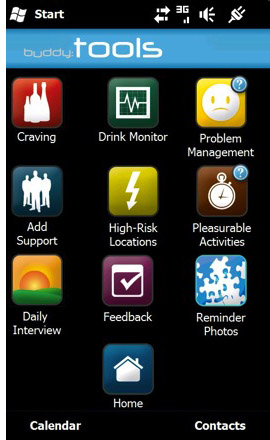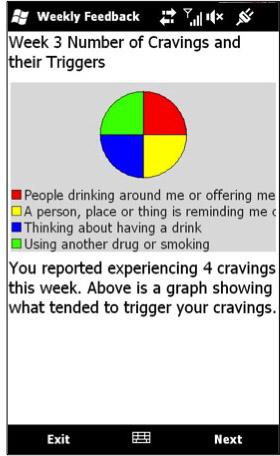UAA researchers design "Buddy" smartphone app to help manage alcohol disorders
by Kathleen McCoy |
For many people, having a glass of wine, a bottle of beer or a margarita rimmed with salt is a way to unwind after a busy day, but for some, the consistent, excessive consumption of alcohol can lead to a destructive path causing harm to themselves and to those around them.
The vast majority of people experiencing problems with alcohol disorders do not seek treatment. "There's an enormous amount of people with an alcohol use disorder but only about 15 to 20 percent of them actually receive some form of treatment," says UAA psychology professor Patrick Dulin, Ph.D.
Some of the reasons, Dulin explains, are the barriers people encounter when seeking treatment, whether it's their personal beliefs-not wanting to admit to having an alcohol problem or be associated with the stigma of alcoholism-or the time and cost commitment of going through a treatment program. He says that stress, depression and other emotions can also get in the way of sobriety.
Dulin's idea of developing a smartphone app to help manage alcohol abuse was sparked when he was working with technology entrepreneurs on another project using GPS systems to identify hunting and fishing boundaries-he began to wonder if a similar system could be applied to the field of psychology.
"What happens too often with addiction is that someone will say, 'I'm just going to take a drive through the old neighborhood or the old bar for old times sake,' what psychologists call a 'seemingly irrelevant decision,' and the next thing they know they're back to heavy drinking," Dulin says. He envisioned a system that would help to keep people on track, particularly when they entered their high risk for drinking locations as well as provide a host of other tools to help them manage their drinking.
He and his colleague Vivian Gonzalez, Ph.D., put together a grant to seek funding to develop and test a "Location-Based Monitoring and Intervention for Alcohol Use Disorders" GPS-enabled system to help people navigate the challenges of their sobriety via a smartphone application. In 2009, the two researchers were awarded a 3-year $1.87M grant from the National Institute on Alcohol Abuse and Alcoholism.
"We saw this as a way to provide a helpful and accessible tool to people who want to change their drinking behavior, but don't want to-or can't-go to a treatment center. There's a big unmet need there that this type of system may be able to help fulfill," says Dulin.
He explains that mHealth, or mobile health, is a hot topic nationally right now, and UAA is on the leading edge of mobile health research and intervention for alcohol use disorders. "This exciting new area has emerged because of advances in cellular technology and smartphones. There's a big push to develop these kinds of systems right now and we are on the cusp."
Dulin and Gonzalez surveyed stacks of literature to ground their proposed system in solid theory before developing a prototype user interface. "We based every piece of the system on empirically-supported alcohol treatment protocols," says Dulin.
The team then worked with a local software company to develop and refine the software, before consulting with leading experts in alcohol treatment, including experts at the Research Institute on Addictions and Syracuse University in New York.
 After working out many bugs and vetting the system, the resulting smartphone app-named
"Buddy"-went through a clinical trial beginning in fall 2011 and concluding in January
2012.
After working out many bugs and vetting the system, the resulting smartphone app-named
"Buddy"-went through a clinical trial beginning in fall 2011 and concluding in January
2012.
Thirty people were selected from a pool of hundreds of interested community members to be a part of Buddy's test group. "People had to meet certain criteria to participate," says Dulin. "They had to be actively drinking-and drinking heavily." He explains that participants had to reach the Diagnostic and Statistical Manual of Mental Disorders criteria for an alcohol use disorder, which includes role impairment, hazardous use, legal problems relating to alcohol use and social or interpersonal problems due to alcohol.
At the start of the study, each participant was issued a smartphone to begin the six-week trial period. The first step was for participants to complete an assessment of their current drinking behavior: how much they're drinking, where and when they're drinking, how much they're drinking in comparison to others, potential triggers and their motivations for wanting to stop drinking.
"The information that's collected at the get-go is woven into different parts of the system," Dulin says. "Buddy doesn't try to force a person to stop drinking; it's designed to be a self-administered tool with a great deal of user autonomy. It gives people a host of in-the-moment intervention strategies for managing their behavior, rather than having to wait until their next appointment with a therapist."
Buddy features numerous modules to help people change their drinking including: Craving, Problem Management, Support Persons, High-Risk Locations, Communications and Pleasurable Activities. Information that a user inputs regularly into the system is compiled in a weekly feedback report so they can grasp a better understanding of their consumption habits.
The Craving Module provides instruction to participants about the nature of craving, how they come and go and also what triggers cravings. Dulin says that this module presents participants with a host of empirically supported strategies to manage cravings, including "urge surfing"-a meditation-type exercise that suggests riding the craving out until it wanes. Other strategies include calling a support person or attending a local AA meeting (Buddy uses GPS technology to identify the nearest meeting locations and times).
The Problem Management Module helps participants think through different situations with problem-solving therapy. If a person is feeling angry, anxious or depressed, Buddy will present some simple solutions for overcoming those emotions (e.g., taking a yoga class, going to a movie with a friend, using a relaxation exercise or trying a new recipe).
The Support Persons Module allows participants to input a list of contacts into their Buddy system to create a support network to help them in their efforts to change their drinking. "This module gives people an easy way to contact supportive people in a time of crisis," Dulin says.
In the High-Risk Locations Module, users input a list of places where they previously drank or purchased alcohol. When the participant nears a high-risk location, Buddy-using its GPS technology-will intervene and send an alert to the person that they are nearing the location.
The Pleasurable Activities Module encourages participants to identify the activities they enjoy doing and schedule events into their calendar during times when they would've normally gone drinking. "It's simple things, like cooking, taking the dog for a walk or going for a swim, things they can fill their time with besides drinking," explains Dulin.
Each day, participants completed a short interview to record their cravings, emotions, drinking behavior and triggers; information from the daily interviews was then delivered in a weekly report to illustrate progress. "The feedback feature was one of the most popular features of the system," says Dulin. "People loved the ability to track their drinking and see improvements over the six weeks. It gave them-and the people around them-a lot more awareness about their drinking and what was contributing to that drinking."
 Twenty-eight people completed the six-week trial period and the overall feedback of
the system was positive. Participants reported a 50 percent reduction in drinking
while using the system and their days of hazardous drinking (5+ drinks/day for men
and 4+ drinks/day for women) were reduced by more than two-thirds.
Twenty-eight people completed the six-week trial period and the overall feedback of
the system was positive. Participants reported a 50 percent reduction in drinking
while using the system and their days of hazardous drinking (5+ drinks/day for men
and 4+ drinks/day for women) were reduced by more than two-thirds.
One challenge of the system was that participants were required to carry the Buddy phone separately from their personal phone. Dulin explains that the test program was developed for a now-outdated phone platform, but that in the future the software will be developed for other operating systems so people can use the app on their own phones (iPhones, Andriods, etc.). "We had people tell us that they would continue to use the app if they could," Dulin says, "and some people said that they were surprised because they didn't think Buddy would help them, but it did."
A second piece of the research included testing the results of the smartphone Buddy group against another group that used a web-based model called the Drinker's Check-Up-a system developed at the University of New Mexico-to see if participants benefitted more from a mobile- or web-based platform. This phase of the research wrapped up in June and the results are still pending.
With over 500,000 apps out there in the mobile universe, it's important to have a solid system in place before making an app available to the public. "There are a lot of rinky-dink alcohol support apps out there, but none that I know of that are grounded in empirically supported research," Dulin says.
The hope is to eventually make Buddy publicly available, but it's not yet at that stage, according to Dulin. Next steps will involve fully analyzing the data, writing manuscripts and publishing findings. With their current grant funding ending this month, the research team intends to apply for more funds-possibly as soon as this fall semester-to complete a larger scale effectiveness study.
Read more about this research online.
See KTUU report by Ted Lamb, dated June 21, 2012.
Watch a short video of UAA researcher Patrick Dulin explaining his research (filmed in 2011).
 "UAA researchers design "Buddy" smartphone app to help manage alcohol disorders" is licensed under a Creative Commons Attribution-NonCommercial 4.0 International License.
"UAA researchers design "Buddy" smartphone app to help manage alcohol disorders" is licensed under a Creative Commons Attribution-NonCommercial 4.0 International License.









